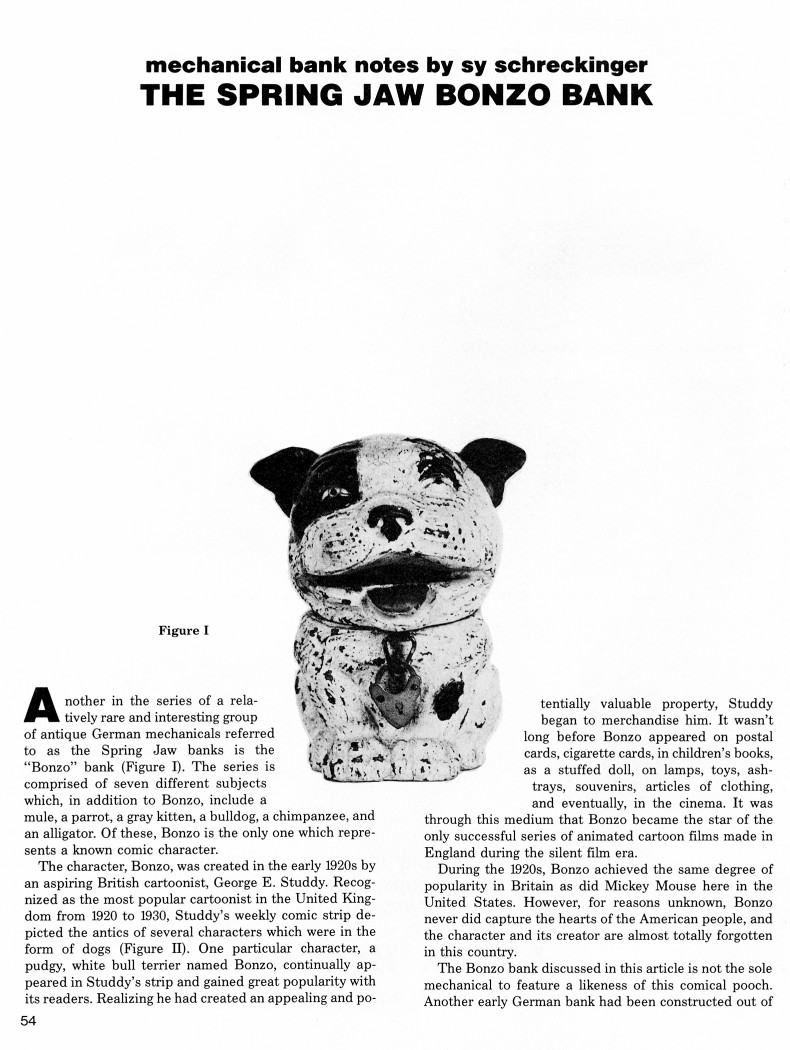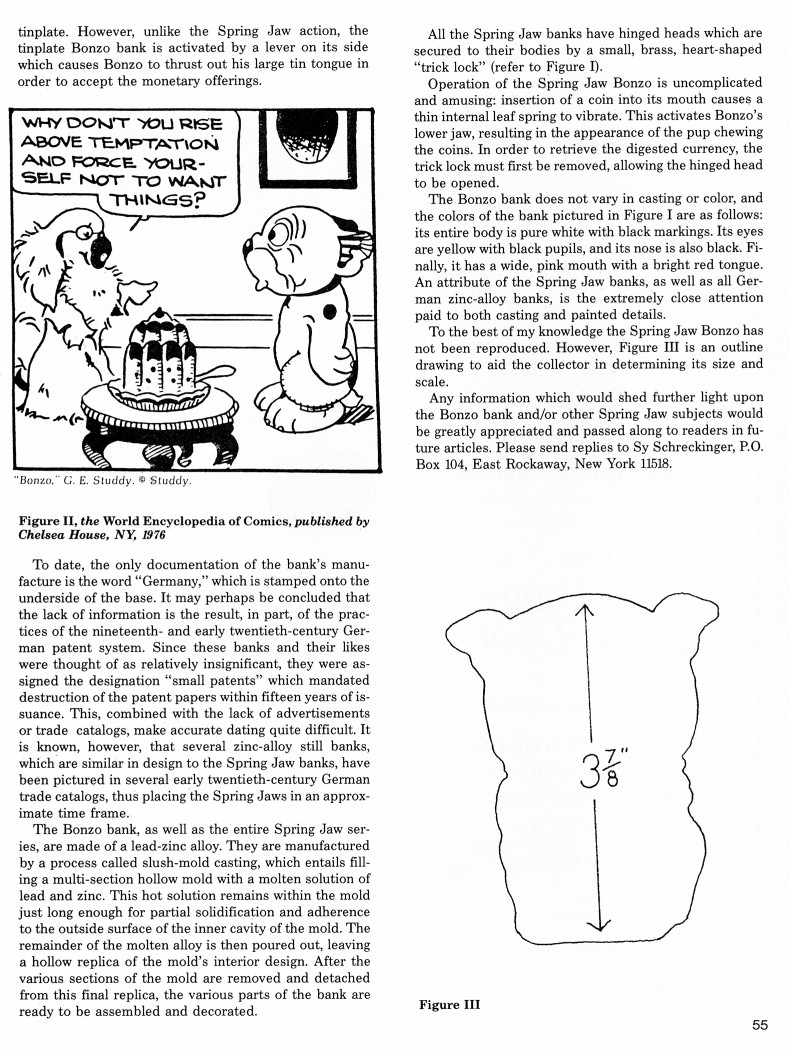|
The Spring Jaw Bonzo
Bank
by Sy Schreckinger – ANTIQUE TOY WORLD Magazine – October, 1988
Another in the series of a relatively rare and interesting group of
antique German mechanicals referred to as the Spring Jaw banks is the "Bonzo"
bank (Figure I). The series is comprised of seven different subjects
which, in addition to Bonzo, include a mule, a parrot, a gray kitten, a
bulldog, a chimpanzee, and an alligator. Of these, Bonzo is the only one
which represents a known comic character.
The character, Bonzo, was created in the early 1920s by an aspiring
British cartoonist, George E. Studdy. Recognized as the most popular
cartoonist in the United Kingdom from 1920 to 1930, Studdy's weekly comic
strip depicted the antics of several characters which were in the form of
dogs (Figure II). One particular character, a pudgy, white bull terrier
named Bonzo, continually appeared in Studdy's strip and gained great
popularity with its readers. Realizing he had created an appealing and
potentially valuable property, Studdy began to merchandise him. It wasn't
long before Bonzo appeared on postal cards, cigarette cards, in children's
books, as a stuffed doll, on lamps, toys, ashtrays, souvenirs, articles of
clothing, and eventually, in the cinema. It was through this medium that
Bonzo became the star of the only successful series of animated cartoon
films made in England during the silent film era.
During the 1920s, Bonzo achieved the same degree of popularity in
Britain as did Mickey Mouse here in the United States. However, for
reasons unknown, Bonzo never did capture the hearts of the American
people, and the character and its creator are almost totally forgotten in
this country.
The Bonzo bank discussed in this article is not the sole mechanical
to feature a likeness of this comical pooch. Another early German bank had
been constructed out of tinplate. However, unlike the Spring Jaw action,
the tinplate Bonzo bank is activated by a lever on its side which causes
Bonzo to thrust out his large tin tongue in order to accept the monetary
offerings.
To date, the only documentation of the bank's manufacture is the word
"Germany," which is stamped onto the underside of the base. It may perhaps
be concluded that the lack of information is the result, in part, of the
practices of the nineteenth and early twentieth-century German patent
system. Since these banks and their likes were thought of as relatively
insignificant, they were assigned the designation "small patents" which
mandated destruction of the patent papers within fifteen years of
issuance. This, combined with the lack of advertisements or trade
catalogs, make accurate dating quite difficult. It is known, however, that
several zinc-alloy still banks, which are similar in design to the Spring
Jaw banks, have been pictured in several early twentieth-century German
trade catalogs, thus placing the Spring Jaws in an approximate time frame.
The Bonzo bank, as well as the entire Spring Jaw series, are made of
a lead-zinc alloy. They are manufactured by a process called slush-mold
casting, which entails filling a multi-section hollow mold with a molten
solution of lead and zinc. This hot solution remains within the mold just
long enough for partial solidification and adherence to the outside
surface of the inner cavity of the mold. The remainder of the molten alloy
is then poured out, leaving a hollow replica of the mold's interior
design. After the various sections of the mold are removed and detached
from this final replica, the various parts of the bank are ready to be
assembled and decorated.
All the Spring Jaw banks have hinged heads which are secured to their
bodies by a small, brass, heart-shaped "trick lock" (refer to Figure I).
Operation of the Spring Jaw Bonzo is uncomplicated and amusing:
insertion of a coin into its mouth causes a thin internal leaf spring to
vibrate. This activates Bonzo's lower jaw, resulting in the appearance of
the pup chewing the coins. In order to retrieve the digested currency, the
trick lock must first be removed, allowing the hinged head to be opened.
The Bonzo bank does not vary in casting or color, and the colors of
the bank pictured in Figure I are as follows: its entire body is pure
white with black markings. Its eyes are yellow with black pupils, and its
nose is also black. Finally, it has a wide, pink mouth with a bright red
tongue. An attribute of the Spring Jaw banks, as well as all German
zinc-alloy banks, is the extremely close attention paid to both casting
and painted details.
To the best of my knowledge the Spring Jaw Bonzo has not been
reproduced. However, Figure III is an outline drawing to aid the collector
in determining its size and scale.
Any information which would shed further light upon the Bonzo bank
and/or other Spring Jaw subjects would be greatly appreciated and passed
along to readers in future articles. Please send replies to Sy
Schreckinger, P.O. Box 104, East Rockaway, New York 11518.
|


